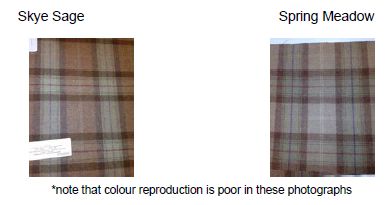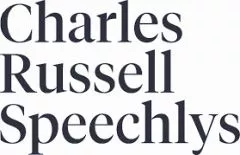Background
The claimant, Abraham Moon Limited, designed a fabric in 2004, which it called "Skye Sage", which had been sold as a furnishing fabric since 2005. It became one of their bestsellers. In 2010, the claimant discovered that a company called "Art of the Loom" was selling a furnishing fabric similar to theirs, called "Spring Meadow". The Spring Meadow fabric was available at John Lewis, one of the claimant's best customers and proceedings eventually followed1.
The claimant's Sky Sage fabric is shown below on the left. The infringing Spring Meadow fabric is shown on the right.

The claimants alleged copyright infringement. Copyright was argued to subsist both in the fabric itself and in the "ticket stamp" used to make the fabric itself. A ticket stamp is essentially a piece of paper (in this instance comprising only two pages) containing words and numbers, which are used as the instructions to set up a loom to weave a fabric with a specific design. The defendants denied infringement, claiming that their fabric was designed independently, and argued that no relevant copyright could subsist in the ticket stamp.
The decision
HHJ Colin Birss QC held that:
- The Skye Sage fabric was an original work that had not been copied from another source (as the defendant had alleged).
- The Spring Meadow fabric had a virtually identical pattern of lines and blocks to the Skye Sage fabric and whilst the colours were not identical, they were very similar. He noted that whilst there was a huge range of tartan fabrics, many of which were similar, the degree of similarity in these two fabrics was "of a different degree". The judge rejected the suggestion that similarities were as a result of design constraints. He found it hard to believe that the similarity in pattern and colour was a coincidence.
- The Skye Sage ticket stamp was a literary work within the meaning of s.3 of the Copyright Designs and Patents Act ("CDPA"). The key information of the Spring Meadow ticket stamp was derived from the "Skye Sage" ticket stamp. The judge described the relationship between the two as a "translation of a text from one language to another". He acknowledged that the derivation was indirect (in that the ticket stamp itself was not copied, rather, the fabric was). The Spring Meadow ticket stamp reproduced a substantial part of the literary work embodied in the Skye Sage ticket stamp and was made by indirectly copying the literary work.
- By contrast, the Spring Meadow fabric itself was not a reproduction of the literary work embodied in the Skye Sage ticket stamp, as it was not a copy of instructions.
- The Skye Sage ticket stamp was also an artistic work within the meaning of s.4 CDPA. This could be considered as a graphic work (which is one of several types of artistic work defined within s.4) as it could be seen as a record of a visual image. The judge noted that an experienced fabric designer would be able to visualise what the fabric would look like from the ticket stamp and so it did have real visual significance, albeit only to some people. The appearance of the Spring Meadow fabric reproduced the whole or a substantial part of the appearance of Skye Sage and so was a reproduction of the whole or a substantial part of the artistic work embodied in the Skye Sage ticket stamp.
- On this point, the judge said that the process by which Spring Meadow is made was irrelevant, as a cotton fabric printed with an image of the Spring Meadow plaid would be just as much of an infringement if it reproduced the appearance of Skye Sage. It did not matter that the ticket stamp was a set of instructions; rather it was the fact that the ticket stamp was a record of an image and that image is what had been reproduced.
Summary
This Patent County Court decision is likely to be of interest to fabric designers and manufacturers. The case provides a useful consideration of the law concerning literary and artistic copyright works and infringement. However, what is particularly unusual is the conclusion that a written series of instructions (in this case to set up loom machines to make a fabric of a specific design) can amount not only to a literary work, but also to an artistic work. (In this case, the former was infringed by the defendants' own design ticket stamp (i.e. series of instructions) and the latter was infringed by the making of the defendants' fabric).
APPENDIX
Relevant Legislative Provisions
Copyright, Designs and Patents Act 1988
Section 1(1)(a): Copyright and copyright works
Copyright is a property right which subsists in accordance with this Part in the following descriptions of work original literary, dramatic, musical or artistic works...
Section 3(1): Literary, dramatic and musical works
In this Part "literary work" means any work, other than a dramatic or musical work, which is written, spoken or sung, and accordingly includes—
a) a table or compilation other than a database
b) a computer program;
c) preparatory design material for a computer program and
d) a database
Section 4: Artistic works
1) In this Part "artistic work" means—
a) a graphic work, photograph, sculpture or collage, irrespective of artistic quality,
b) a work of architecture being a building or a model for a building, or
c) a work of artistic craftsmanship.
2) In this Part..."graphic work" includes—
a) any painting, drawing, diagram, map, chart or plan, and
b) any engraving, etching, lithograph, woodcut or similar work;
Section 16: The acts restricted by copyright in a work
1) The owner of the copyright in a work has, in accordance with the following provisions of this Chapter, the exclusive right to do the following acts in the United Kingdom—
a) to copy the work (see section 17);
b) to issue copies of the work to the public (see section 18); ba) to rent or lend the work to the public (see section 18A);
c) to perform, show or play the work in public (see section 19);
d) to communicate the work to the public (see section 20);
e) to make an adaptation of the work or do any of the above in relation to an adaptation (see section 21); and those acts are referred to in this Part as the "acts restricted by the copyright".
2) Copyright in a work is infringed by a person who without the licence of the copyright owner does, or authorises another to do, any of the acts restricted by the copyright.
Section 17: Infringement of copyright by copying
2) Copying in relation to a literary, dramatic, musical or artistic work means reproducing the work in any material form.
This includes storing the work in any medium by electronic means.
3) In relation to an artistic work copying includes the making of a copy in three dimensions of a two-dimensional work and the making of a copy in two dimensions of a three-dimensional work.
The content of this article is intended to provide a general guide to the subject matter. Specialist advice should be sought about your specific circumstances.


